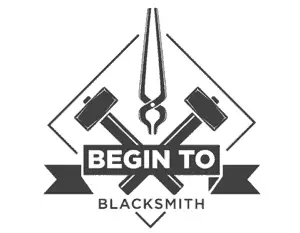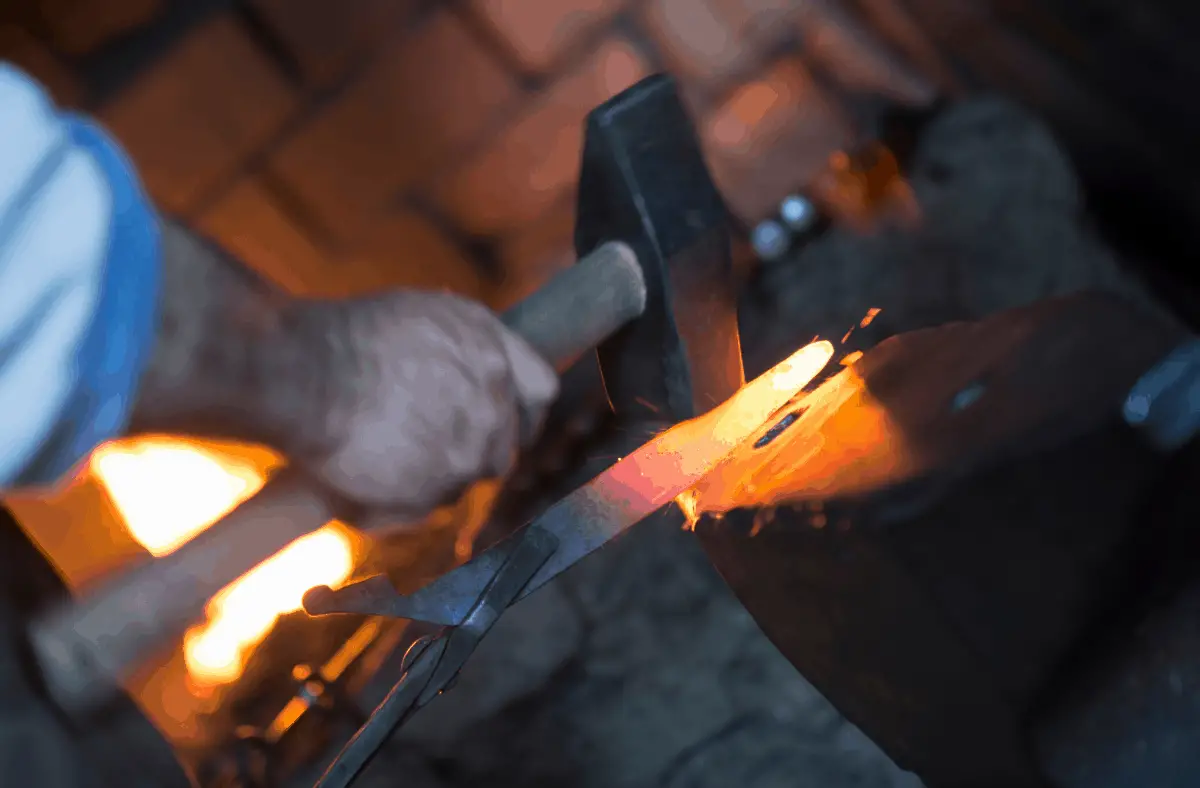Beginner blacksmiths looking to get started often tell me that they want to learn how to make a blade. Whether that be some sort of sword or another weapon, I generally recommend beginners learn to make a knife.
For one, there are plenty of different types of knives out there to make. In another article I wrote on the best projects for beginner blacksmiths, chef knives were pretty high on my list of things I’d recommend beginners to make. However, even something like a tactical survival knife is pretty simple to make, as well.
For this beginner’s outline, we’re going to go over the basics of how to make a 6-inch survival knife. You’re more than welcome to make a larger knife if you’d like, especially since the process is going to be more or less the same.
Let’s begin.
What materials do you need?
As for materials, you don’t need too much to get started. Any piece of steel or iron as a stock that’s the appropriate size will do.
If you watch some blacksmithing videos online, you’ll find that many experts like to use some pretty complicated techniques when they make their blades. This includes stacking several layers of steel or iron on top of one another, cutting it half, and then splitting it against itself. These kinds of techniques create a unique pattern in the metal that makes your blade look incredibly well-crafted.
While these types of techniques are definitely worth aiming for once you’re more experienced, beginner blacksmiths shouldn’t really get to worried about doing anything fancy like that. Instead, focusing on making as many knives, swords, and other bladed projects is the best way to both improve your skills as well as have fun.
What equipment do you need?
As for equipment, you actually don’t need that much. While it’s easy to get overwhelmed with all the little tools and things you can buy for yourself, all you really need are the basics.
A forge (gas-powered is what I recommend for beginners), alongside an anvil, a hammer, some tongs, as well as a few other odds and ends are all you really need. You’re going to want some kind of workbench, as well as some grinder discs, a set of files, as well as some sandpaper.
All in all, you can get all of these things for less than $400 is you know what you’re doing, potentially even less (here’s an article where I talk about how to get started blacksmithing with less than $200). Most of this figure is going to come from buying a forge if you haven’t already. Again, I recommend a gas-powered forge for beginners, especially since they are easier to operate, clean, and are significantly cheaper than other types on the market.

My favorite is the Simond Store Portable Propane Gas Forge. While there’s a somewhat larger, triple-burner version that you can get on Amazon, I honestly think the slightly smaller, single-burner variant is a bit better for beginners. Not only is it cheaper, but it’s also more than large enough to handle most blacksmithing projects that beginners would need.
Step #1: Coming up with the design
Before you begin, the first thing you should do is make an outline of the dimensions of your planned knife design. For the purpose of this guide, I’m going with a 6-inch long blade that’s 2-inches in diameter, but you’re welcome to change this up. Whether your knife is longer, thicker, smaller, or anything else, the basic outline of this article remains the same.
A general rule of thumb is that two-thirds of your survival knife will be the blade itself, while the remaining one-third will be your handle. So for a 6-inch blade set aside another 3-inches for your handle. When you come up with the design, be sure to take this into account.
The idea here is that you will make a basic outline on a sheet of paper. Then, you’ll put this outline on top of your steel and use a pen to mark on the metal the outline of your design. This will be like a rough blueprint for you to follow as you hammer away at your steel. That way, you can keep the rough design you have in mind as you work on your stock.
Step #2: Begin forging
When it comes to forging most blades, the first couple of steps tend to be the same. Come up with a basic design and hammer away at your metal until it roughly fits what you’re looking for.
It’s the same thing when forging a blade. The piece of metal you picked likely is bigger than the dimensions for your knife that you have in mind. Most of the time, workshops will simply use a high-powered saw to cut away at the excess metal and get the exact size you’re looking for. Since beginner blacksmiths likely don’t have that kind of money to buy such a machine, you will have to simply hammer away instead.
Heat up your metal until its hot. Then comes the hard part. You’re going to have to hammer away at your metal for quite some time until you get to the exact size you’re looking for.
*NOTE* I’m making the assumption that the piece of metal you picked is relatively flat and thin. If instead you chose a piece that’s thick (say something like rebar, for example), then as you flatten it out with your hammer, the metal is going to spread out and widen. In this case, you need to keep in mind exactly how much wider your metal is going to be after you’re done.
Step #3: Sharpening your blade
Once you’ve got your knife to be roughly how you want it shape-wise, the next step is to grind down the edge and sharpen it. To do this, you’re going to want to sharpen your blade with a grindstone or some other sharpening tool.
Some people end up buying expensive grinding machines in order to sharpen their blades. While that’s definitely an option if you have the money for it, beginner blacksmiths don’t need to spend that much cash this early on in their careers.

Instead, consider buying a belt grinder. While it’s not a mandatory purchase for aspiring blacksmiths, if you’re serious about knifemaking or forging blades, then it’s going to be something that you’ll need to buy sooner or later.
You can find affordable belt grinders for around $150 or so. While that’s a little pricey, it’s definitely a worthwhile investment that can save you hours of time while you sharpen your blades.
*NOTE* If you’ve never done this before, make sure to keep a bucket of water nearby. Sparks tend to fly while you’re sharpening your knife and its definitely a possibility that a rogue spark could hit something flammable. Make sure to keep your workspace safe, with nothing nearby that can catch on fire.
Step #4: Working on your handle
Believe it or not, the handle is the part of the knife where you have the most choice. There are all sorts of things you can do for a knife handle, some ideas being simpler than others.
One of the simplest options that I recommend for complete beginners is to wrap some wire, string, or leather straps around your handle. That’s the easiest way to make a proper handle for your survival knife that actually looks like it fits while still being quite functional.
As you’d imagine, its pretty easy to do. Just get yourself some string or leather straps and wrap it around your handle and then tie it up. Just like that, you’ve made your first knife, congratulations!
Other options
If you think that’s a little too easy, then you are welcome to try doing something more complicated. Many knifemakers like to add custom wooden grips to their handles while screwing on a pommel on the bottom. Other’s like to simply put two matching pieces of wood on either side of your knife while using some screws to screw them together.
For this second approach, you’re going to have to actually punch holes in the metal part of the handle where you expect to put your screws. You’re also going to have to have a threading machine or something similar so that you can put the groove patterns of the screw into the wooden pieces and the handle itself.
This second option is a bit more complicated, but it’s not unrealistic for a beginner blacksmith. It’s just going to require some more tools that you may or may not have. Primarily, you’re going to need a threader or some kind.

However, you don’t even need to go with either of these approaches. You can simply make a basic, one-piece survival knife with nothing on the handle. Maybe just smooth it out a little with a grinder, and you can just use it as is. That tends to be the case with other types of knives, like chef knives, where its common for the knife to be just one piece of metal with a smooth, metal grip.
Step #5: Final touches
At this point, you’re essentially done. Depending on what kind of material you used to make your knife (whether carbon steel, iron, or some other piece of junk metal you had lying around), you might need to use a file to clean up your blade a little. Using a belt grinder on the flat side of the blade will be enough to clean off any black flakes or other discolorations on the blade. However, using a file can also chip away at some of these flakes as well.
This is also the part where you can try to put some engravings on the side of your knife’s blade if you’d like. If you want to take this approach, you’re going to need a rotary tool which includes an electric engraver. The exact pattern or style of engraving that you’re going for is up to you and is beyond the scope of this basic guide. However, it’s not something that’s overly difficult for beginner blacksmiths to accomplish.

Conclusion
The beauty of knifemaking is that is can be incredibly simple for beginner blacksmiths to get started but can be equally as challenging for veterans. There are tons of different types of elaborate patterns and styles of knives that you can make as your skills improve.
What’s more, knifemaking is a pretty profitable hobby. It’s one of the few aspects of blacksmithing that beginners can make quite a bit of money from. A quick look on websites such as Etsy will find dozens of different blacksmithing outfits that sell custom made knives online. Often, these knives can sell for hundreds of dollars.
Of course, you’re going to need to have some degree of craftsmanship when trying to sell a knife online. Simply making a basic, beginner’s blade isn’t going to suffice. However, once you’ve practiced enough to become good at knifemaking, don’t be surprised if you end up making a pretty good side income (or even full-time income) by selling knives online.
Recommended Reading:
Best Blacksmithing Forges for Beginners
The Best Beginner Blacksmithing Projects – 2021 Edition
Begin to Blacksmith is a participant in the Amazon Services LLC Associates Program, an affiliate advertising program designed to provide a means for sites to earn advertising fees by advertising and linking to Amazon.com. I get commissions for purchases made through links in this post.

